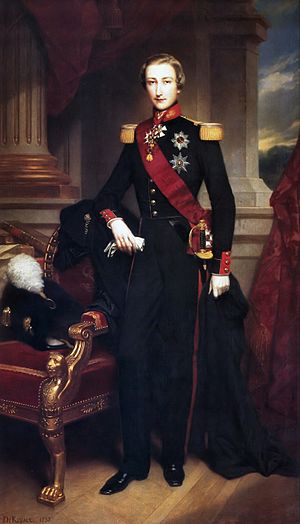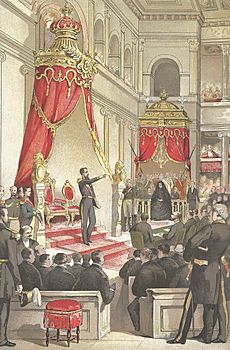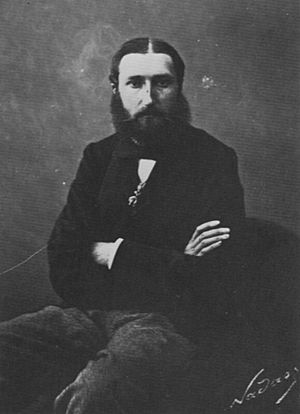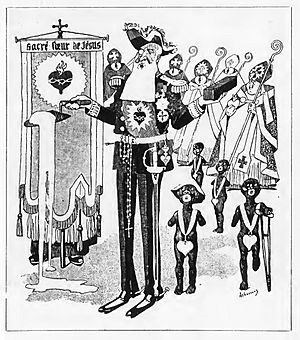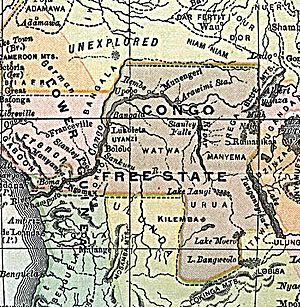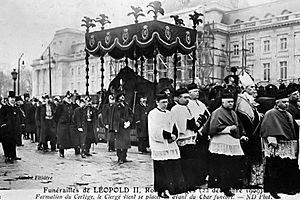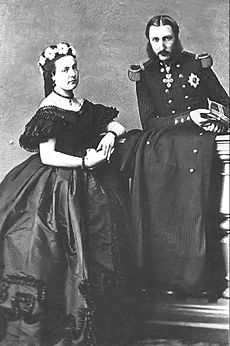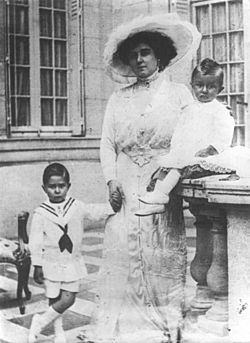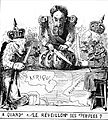Leopold II of Belgium facts for kids
Quick facts for kids Leopold II |
|
|---|---|
 |
|
| King of the Belgians | |
| Reign | 17 December 1865 – 17 December 1909 |
| Predecessor | Leopold I |
| Successor | Albert I |
| Born | 9 April 1835 Royal Palace, Brussels, Belgium |
| Died | 17 December 1909 (aged 74) Royal Palace, Laeken, Belgium |
| Spouse | Marie Henriette of Austria |
| Issue | Louise Marie, Princess of Kohary Prince Leopold, Duke of Brabant Stéphanie, Crown Princess of Austria Clémentine, Princess Napoléon |
| House | House of Saxe-Coburg and Gotha |
| Father | Leopold I |
| Mother | Louise of Orléans |
| Religion | Roman Catholic |
Leopold II (born Léopold Louis Philippe Marie Victor, 9 April 1835 – 17 December 1909) was the King of the Belgians. He was born in Brussels, Belgium. He was the second son of Leopold I and Louise of Orléans. Leopold II became king on 17 December 1865, after his father passed away. He ruled until his own death in 1909.
Leopold II is mostly remembered for creating and owning the Congo Free State. This area is now known as the Democratic Republic of the Congo. He claimed the Congo as his personal property. He treated the local people very poorly to make a lot of money. His harsh rule caused many people in the Congo to suffer greatly. The situation in the Congo became a huge international scandal in the early 1900s. Because of this, Leopold was forced to give control of the Congo to the government of Belgium.
Contents
Early Life and Family Connections
Leopold was born in Brussels on 9 April 1835. He was the second child of the Belgian King, Leopold I, and his second wife, Louise of Orléans. Louise was the daughter of Louis Philippe I, who was the King of France.
In 1848, the French Revolution of 1848 happened. This forced Leopold's grandfather, King Louis Philippe, to leave France and go to the United Kingdom. Two years later, in 1850, Louis Philippe died. Leopold's mother, Louise, was very sad about her father's death. Her health got worse, and she died from tuberculosis that same year. Leopold was 15 years old at the time.
Leopold's sister, Charlotte, later became Empress Carlota of Mexico in the 1860s. The British Queen at that time, Queen Victoria, was Leopold II's first cousin. This is because Leopold's father and Victoria's mother were brother and sister.
Marriage and Children
When he was 18, Leopold married Marie Henriette of Austria. She was a cousin of Emperor Franz Joseph I of Austria. They got married on 22 August 1853 in Brussels. Marie Henriette was lively and full of energy. People liked her because she was kind and generous. She was also a talented artist and musician. She loved horseback riding and even took care of her horses herself.
Leopold and Marie Henriette had four children: three daughters and one son. Their son was named Prince Leopold, Duke of Brabant. Sadly, the younger Leopold died in 1869 when he was nine years old. He passed away from pneumonia after falling into a pond. His death made King Leopold very sad. After this, their marriage became unhappy, and they separated. Marie Henriette moved to Spa in 1895 and died there in 1902.
Early Career in Politics
Leopold was the heir to the throne from the day he was born. This was because his older brother, Louis Philippe, had died the year before Leopold was born. When Leopold was 9 years old, he received the title of Duke of Brabant. He also joined the army as a sub-lieutenant. He stayed in the army until he became king in 1865, reaching the rank of lieutenant-general.
Leopold's public work began when he turned 20 in 1855. He became a member of the Belgian Senate. He was very interested in the Senate's work, especially in how Belgium could grow and trade more. He also started to suggest that Belgium should get colonies. From 1854 to 1865, Leopold traveled a lot. He visited places like India, China, Egypt, and countries along the Mediterranean Sea. His father died on 10 December 1865, and Leopold became king on 17 December, at the age of 30.
Belgium Under Leopold II
Leopold became king in 1865. He wanted Belgium to be "strong, prosperous, therefore have colonies of her own, beautiful and calm." He wrote this in a letter to his brother in 1888.
Many important political changes happened during Leopold's time as king. The Liberals were in charge of Belgium from 1857 to 1880. They passed a law in 1879 that created free, non-religious primary schools supported by the government. This law also stopped government support for Roman Catholic primary schools. In 1880, the Catholic Party gained power. Four years later, they brought back government support for Catholic schools. In 1885, different groups of workers came together to form the Labour Party. As more people became unhappy and the Labour Party grew, the government had to allow all men to vote in 1893.
Other social changes also became law during Leopold's rule. Workers gained the right to form labor unions. Laws were passed to protect children. For example, children younger than 12 were not allowed to work in factories. Children younger than 16 could not work at night. Women younger than 21 were not allowed to work underground. Workers also got the right to be paid if they were hurt at work, and they were given Sundays off.
The Belgian Constitution was changed for the first time in 1893. All men were given the right to vote, though some men had more votes than others. The rules for becoming a member of the Senate were made easier. Elections would also use a system called proportional representation, which is still used today. Leopold wanted to have a "royal referendum." This would have allowed the king to ask the public directly about an issue and use their answer to make decisions. But this idea was rejected because it would have given the king too much power over the elected government. Leopold was so upset that he thought about giving up his throne.
Leopold believed that military defense was key to keeping Belgium neutral. He worked to make Belgium stronger militarily. He built defensive forts at Liège, at Namur, and at Antwerp. During the Franco-Prussian War, he successfully kept Belgium neutral, even though it was a very difficult and dangerous time. Leopold also pushed for changes in military service. Before, men could pay someone else to serve in the army for them. This was changed to a system where one son from every family had to serve in the military. This change happened just before he died.
The Builder King's Projects
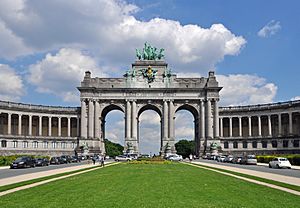
Leopold ordered the building of many grand buildings, city projects, and public works. He mostly paid for these projects with the money he made from the Congo Free State. Because of all these buildings, he was called the "Builder King." These public buildings were mainly in Brussels, Ostend, Tervuren, and Antwerp. Some examples include the Parc du Cinquantenaire/Jubelpark (1852-1880), its memorial arcade, the Basilica of the Sacred Heart (1905-1969), and Duden Park in Brussels (1881). In Ostend, he built the Hippodrome Wellington racetrack (1883) and the Royal Galleries (1902). He also built the Royal Museum for Central Africa and its park in Tervuren (1898), and helped with the Antwerpen-Centraal railway station in Antwerp (1895–1905).
Besides public works, Leopold also bought and built many private properties for himself. He made the Royal Castle of Laeken bigger and built the Royal Greenhouses. He also added the Japanese Tower and the Chinese Pavilion near the palace, which are now part of the Museums of the Far East. In the Ardennes region, he owned a huge area of forests and farmlands, along with several castles. He also built important country homes on the French Riviera, like the Villa des Cèdres with its beautiful garden, and the Villa Leopolda.
Leopold thought about what would happen to his properties after he died. He didn't want his large collection of estates, lands, and historic buildings to be divided among his daughters, who were all married to foreign princes. So, in 1900, he created the Royal Trust. Through this, he gave most of his properties to the Belgian nation forever. He also made sure that the royal family could continue to use them after his death.
The Congo Free State
Leopold was the founder and the only owner of the Congo Free State. This was a personal project he started on his own. He used the explorer Henry Morton Stanley to help him claim the Congo region. This area is now known as the Democratic Republic of the Congo. At the Berlin Conference in 1884–1885, European countries agreed to his claim. They expected him to improve the lives of the people in the Congo Free State.
However, Leopold did not follow these conditions from the start. He ran the Congo for his own wealth, using a private army called the Force Publique. If people failed to collect enough rubber, they could be killed. Leopold made a huge fortune from the Congo. At first, he collected ivory. Later, when the price of rubber went up in the 1890s, he forced people to work to harvest and process rubber.
Under his rule, many Congolese people died from harsh treatment, disease, and hunger.
The Congo Free State later became a Belgian colony called the Belgian Congo. This happened under the control of the Belgian parliament. Leopold tried very hard to hide any proof of the terrible things that happened during his time as ruler of his private colony. He had all the records of the Congo Free State burned. He told his helper that even though the Congo was taken from him, "they have no right to know what I did there." The Congo gained its independence in 1960.
Death and Legacy
Leopold II died on 17 December 1909, in Laeken. The Belgian crown then passed to Albert I, who was the son of Leopold's brother, Philippe. When Leopold's funeral procession passed, some people booed. This showed that they did not approve of his rule. Leopold's reign lasted exactly 44 years, which is the longest in Belgian history. He was buried in the royal vault at the Church of Our Lady of Laeken.
Family Life
Leopold's sister became Empress Carlota of Mexico. His first cousins included both Queen Victoria of the United Kingdom and her husband Prince Albert. He was also a cousin to King Fernando II of Portugal.
He had four children with Queen Marie Henriette:
- Princess Louise of Belgium: Born in Brussels on 18 February 1858. She married Prince Philipp of Saxe-Coburg and Gotha and had two children.
- Prince Leopold, Duke of Brabant: Born in Laeken on 12 June 1859. He died in Laeken on 22 January 1869, from pneumonia, after falling into a pond.
- Princess Stéphanie of Belgium: Born in Laeken on 21 May 1864.
- Princess Clémentine of Belgium: Born in Laeken on 30 July 1872. She married Prince Napoléon Victor Jérôme Frédéric Bonaparte. The current head of the Imperial family, Jean-Christophe, Prince Napoléon, is a direct descendant of King Leopold II.
Leopold also had two sons with Caroline Lacroix. These sons were adopted by Caroline's second husband in 1910. Leopold gave them honorary titles, but these were not official because the parliament would not have supported them.
Titles and Styles
- 9 April 1835 – 17 December 1865: His Royal Highness The Duke of Brabant, Prince of Saxe-Coburg and Gotha. Duke in Saxony.
- 17 December 1865 – 17 December 1909: His Majesty The King of The Belgians. Prince of Saxe-Coburg and Gotha, Duke in Saxony.
Images for kids
See also
 In Spanish: Leopoldo II de Bélgica para niños
In Spanish: Leopoldo II de Bélgica para niños



